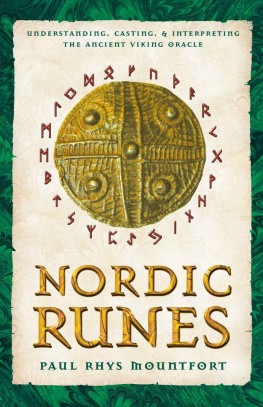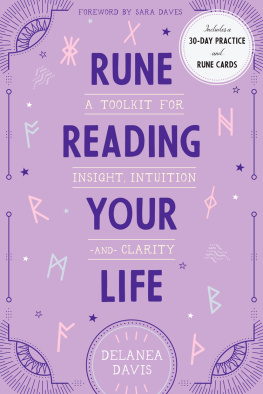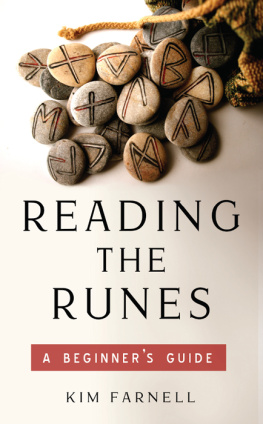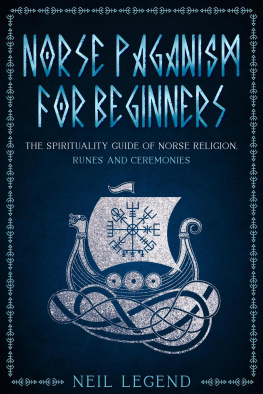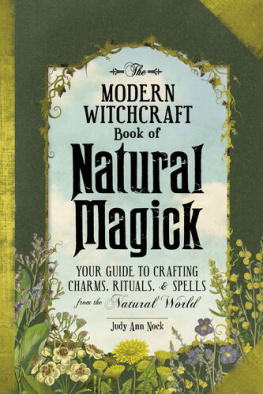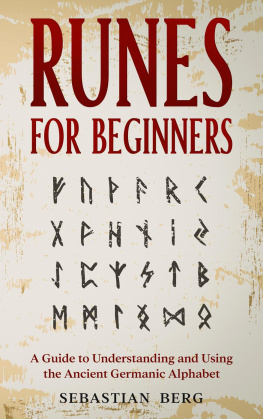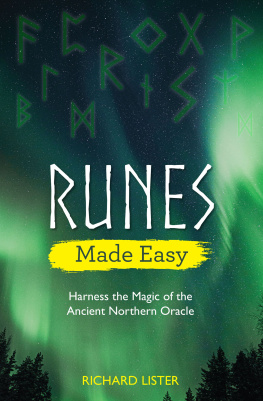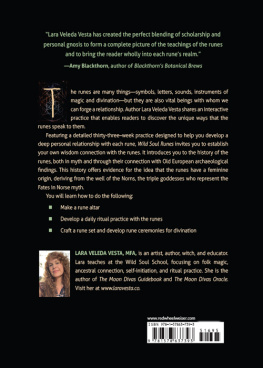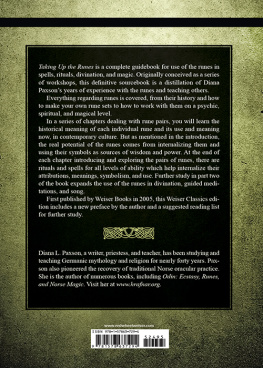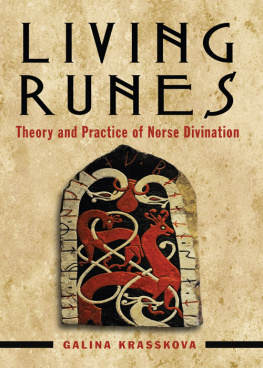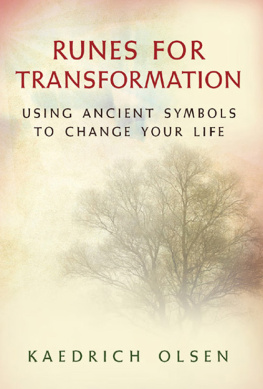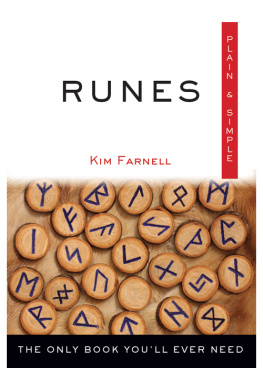

CONTENTS
PREFACE
N ordic Runes is a companion volume to my Ogam: The Celtic Oracle of the Trees and is a similar guide to the earlier book in that it presents a fully functional system of divination based on ancient and authentic materials. Along with an upcoming work, Tarot: Oracle of the West, it forms part of an oracular trilogy that seeks to show that the meanings embodied in the divinatory systems of the ancient Celts and Norse, and of wider western European cultures, with their profound pagan resonances, are far richer than has previously been suspected. Within them we find embodied the primary images, teachings, and techniques of the Western Mysteries. At the same time, these books are intended to be workable, practical systems of divination, and in this Nordic Runes is no exception.
The spell the Runes cast both in the collective imagination and in our individual lives through their use as tokens in divination, magic, and creative visualization is a powerful one indeed. Thisat first sight simpleset of signs expands almost infinitely upon acquaintance to reveal an entire system of magical correspondence and lore. Its oracular signs form a network of pathways no less potent than the Hebrew alphabet does in kabbalism, which has long been a mainstay of Western occultism. As the pages ahead reveal, the Runes contain a blueprint or road map to the Northern Mysteries, and, above and beyond their fortune-telling role, a kind of initiation into a profound cultural tradition. By using the Runes, the reader can not only access this unique wisdom tradition but also participate in its contemporary revival.
A few technical matters need to be addressed to help the reader to navigate the pages ahead with the maximum of ease. The first involves the use of archaic names and other terms. While I have carried over the use of accents from the original Old English, Norwegian, and Icelandic sources, I have (with some regret) not included letters from these languages that do not occur in modern English. To make the mental leap from Odin to the native representation of his name, Oinn, may not present too much of a problem, and with time firr becomes recognizable as Thr, but less familiar terms place unreasonable demands on even the most reasonable reader. However, I have made an exception to this with the titles of poems, sagas, and tales, which seem to me to deserve special treatment; English translations for these follow in parentheses. Another source of confusion may be caused by my selective use of capital letters for the same word in some contexts but not others. As a rule, I use the phrase the Runes to refer to the Elder Futhark alphabet used for runic divination, but runes for the individual letters and more generally for the other rune scripts that existed in centuries past. I also use lowercase to refer to historical forms of paganism, while contemporary Paganism is given a capital P, to draw a distinction between early beliefs and their modern revival. Finally, I follow modern scholarly convention in replacing the outmoded terms B . C . and A . D . with B . C . E . (before the Common Era) and C . E . (Common Era), for obvious reasons.
I would like to thank all those who made this work possible, especially my partner, Claire, and our son, Finn, for their patience, support, and inspiration. Of those who have contributed to the present work directly or indirectly, I would like to acknowledge my mother and father for help and support along the way; the Downey brothers and their extended kin, especially Kirk and Shane; and the indomitable Rhys Hughes. Salutations to Wilson and Margaret Harris for encouraging me in my researches, to Elaine Sanborn and Jon Graham at Inner Traditions for their fabulous enthusiasm, and to that maker of talismans, Paora Te Rangiuaia, for holding the manuscript in magical trust. To Cian MacFhiarais and the other members of the Coven of the Triple Moon, my sincere compliments. Finally, every writer should have a home away from home: My thanks go to the Lazy Lounge Caf, a wayfarers house and safe haven that faces the sea to the north and south. May its owners, Nick and Pat, enjoy the favor of the gods for their generosity of spirit.
THE ORIGIN OF RUNES AND HOWTO USE THIS BOOK
T his book is a complete guide for those who wish to draw on the well of practical and esoteric wisdom embodied in the ancient Runes. It provides the necessary tools for interpreting the runes of good help and the teachings from the Norse wisdom tradition on which they are founded. Having come into prominence some two thousand years ago, the twenty-four runestaves of the ancient Elder Futhark alphabet are more relevant to us today, at the dawn of a new millennium, than ever before. Like the images of the tarot deck and the hexagrams of the I Ching, Runes are profound keys to personal empowerment, self-development, and spiritual awareness.
The Runes are native to traditional northern European cultures. They have deep resonances within the pagan Norse world of high gods and goddesses, elemental forces, giants, dwarfs, warriors, and wizards that inspired, among others, J. R. R. Tolkien in the writing of his fantasy fictions. Ancient tales tell of their discovery by the magician-god Odin and their use in magic and divination. This last, predictive use of Runes continues with us today, in guides such as this. It is, however, the contention of this book that the twenty-four runes of the Elder Futhark are more than mere fortune-telling tokens: they are a potent key to the rich mythological heritage of the Norse world. As we will see, each stave (individual rune) evokes a set of tales and correspondences in ancient Norse myth; they encode a set of profound teachings, an entire wisdom tradition. These teachings, moreover, have a universality and a timelessness to their insights, messages to impart that transcend their northern European origins. To the runecaster, the runic system is a magical mirror of symbols that, through the act of consultation, can be turned to in order to reflect the nature of a situation and offer counsel or guidance.
To divine, in the original sense of the word, is literally to discover higher insight, the workings of fate, or the will of the gods, as it applies to our lives. Divination systems like the Runes are based on sets of meaningful signs, omens that we randomly choose and interpret for their personal message to us. But how could such a procedure possibly work? The traditional Norse answer would be that in the Web of Wyrd (fate, destiny), all things and events resonate in a profound and luminous way and that Runes faithfully record the signature of the energy movements underlying our own unique fate path at the moment of consultation. The scientific rationalism of the West generally does not admit that events that are not causally related can have an underlying connection, but the idea is no longer disreputable even in scientific terms, for the notion of randomness itself has increasingly been subject to scrutiny in modern times. In the 1950s, C. G. Jung introduced the concept of synchronicity, which he described as meaningful coincidence, and some quantum theoreticians have supported his conviction that chance events not physically or causally linked may nonetheless spring from a deeper ordering principle. For all its chaos, we are now entering an exciting time when modern science and ancient magic can at last meet and come into dialogue.
In the ancient world, divination was, of course, attributed to the activity of gods and spirits. Whether we regard such entities as real or metaphorical, it is vitally significant that in northern Europe the highest of all the gods, Odin (who as the Germanic Woden or Wotan gave his name to Wednes day), was himself the discoverer and lord of the Runes. Odin in fact provides the model for mastery of the runic system. In Norse myth, he descends the World Tree and undergoes a sacrifice to haul up the Runes from Mmirs Well. The Well of Mmir can be understood in several ways: as the psyche of the runecaster, the collective unconscious, and the world of energy forms underlying physical matter, for the story of Odins quest is really a code for the process of looking within and attaining therein knowledge of all the worlds. The Runes are the physical tokens of his hard-won wisdom, offered to those to whom they may avail.
Next page
